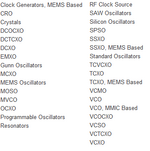matrixofdynamism
Advanced Member level 2

I am creating my first FPGA PCB. It needs clock source.
When I went to Mouser website looking for it, it gave me this list of options contained in the image_1 attached.
When I went to RS website looking for it, it gave me list of options contained in the image_2 attached.
I am basically completely confused by this plethora of options. I just need a single frequency clock source. The frequency range is 10MHz to 100MHz. This is because I might choose a few different components for this PCB. The PCB is being created for purpose of learning PCB design.
What component am I supposed to look for?
When I went to Mouser website looking for it, it gave me this list of options contained in the image_1 attached.
When I went to RS website looking for it, it gave me list of options contained in the image_2 attached.
I am basically completely confused by this plethora of options. I just need a single frequency clock source. The frequency range is 10MHz to 100MHz. This is because I might choose a few different components for this PCB. The PCB is being created for purpose of learning PCB design.
What component am I supposed to look for?


